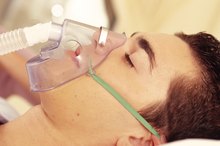The Difference Between Negative or Positive Room Air Pressure
Air pressure in a room is influenced by whether air can enter and leave a room through gaps around windows, above and under doors, around light fixtures and electrical outlets as well as through open doors and windows. Negative and positive air pressure rooms are common in hospitals 1. A negative pressure room primarily keeps its air inside the room with controlled venting only; whereas a positive pressure room keeps unfiltered air from outside the room out of the room all together. Most homes have at least one negative pressure room: the bathroom. When a bathroom door is closed, if the bathroom has a quality working fan, unpleasant odors as well as moisture and humidity are vented out through the fan because the forced air ventilation creates a negative pressure room.
Negative Pressure Isolation Rooms
In a hospital, patients with communicable diseases, especially airborne ones, are kept in isolation rooms. In order to ensure the safety of other patients, staff and visitors, it is important that the isolation room contain negative air pressure 1. This will keep any germs from entering the general airflow and infecting other people. A specially designed ventilation system installed in isolation rooms keeps contaminated air from escaping. In a properly functioning negative pressure room, air is drawn into the room only through a half-inch gap under the door. Windows, light fixtures and outlets are sealed so that air only exits the room through a filtered ventilation system.
- In a hospital, patients with communicable diseases, especially airborne ones, are kept in isolation rooms.
- In order to ensure the safety of other patients, staff and visitors, it is important that the isolation room contain negative air pressure 1.
Negative Pressure Isolation Stations
The Best CPAP BiPAP Masks for High Pressure
Learn More
In some laboratories, staff members working with potentially hazardous materials may use a negative pressure station. Directly above the work space, a powerful ventilation and filtration system will draw the air away and through a HEPA filter specifically designed to keep workers, both in the room and in the building, safe from exposure to any hazardous fumes or air-borne byproducts.
Testing for Negative Pressure
A simple smoke test can ensure that a negative pressure room is working properly 1. To perform this test, close the door to the isolation room and stand in the corridor outside the door. Using a smoke tube, hold the bottom of the tube near the bottom of the door, 2 inches away from the front of the door. Gently squeeze the bulb to release a stream of smoke. It is important that the smoke flow slowly from the tube so that the velocity of the smoke does not overpower the velocity of the air in the corridor. If the negative pressure room is functioning properly, the smoke will be drawn under the door and into the room. If the smoke remains stationary or is blown outward, negative pressure has not been established.
- A simple smoke test can ensure that a negative pressure room is working properly 1.
- If the negative pressure room is functioning properly, the smoke will be drawn under the door and into the room.
Positive Pressure Isolation Rooms
O2 Cylinder Hydrostatic Test Requirements
Learn More
Positive pressure isolation rooms are designed to keep a vulnerable patient in isolation safe from contamination from the outside. The air pressure in the room is greater than that outside of it, so it pushes potential infection agents or chemicals away from the patient. The most common application is in rooms for patients who have compromised immune systems. For these individuals, it is important that no common pathogens, even those that are harmless to healthy people, enter the room. For positive pressure isolation rooms, an anteroom is recommended and incoming air is filtered through both HEPA filters and ultraviolet germicidal irradiation systems, which kill bacteria by exposing them to ultraviolet light.
- Positive pressure isolation rooms are designed to keep a vulnerable patient in isolation safe from contamination from the outside.
- For positive pressure isolation rooms, an anteroom is recommended and incoming air is filtered through both HEPA filters and ultraviolet germicidal irradiation systems, which kill bacteria by exposing them to ultraviolet light.
Related Articles
References
Writer Bio
Bjorck DiMarco has been the Senior Editor at an independent publishing house since 1994. She holds advanced degrees in teaching, English and creative writing, graduating summa cum laude from Tufts University and the University of Massachusetts. DiMarco has also worked in construction, fine woodworking, graphic design and theoretical mathematics.








